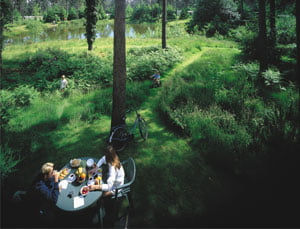
The products and services that an organisation produces are the reason why it exists; timber merchants exist to sell timber, china factories to produce and sell china, holiday firms to sell holidays. These days, however, all businesses are expected to look and think beyond what they produce. Simply by existing and operating, they take upon themselves certain duties and responsibilities. These are not only to their customers, their employees and their shareholders, but also to the world as a whole: to its present inhabitants, to future citizens yet unborn and to the environment as a whole. There is a strong argument that all organisations today should seek to develop principles of conservation within all levels of business activity. This message has not yet been accepted by every country or by every firm, but it is becoming harder to ignore.
As many modern products depend on non-renewable resources, many people are now understandably concerned about how quickly these resources are being used up. In the past, when production levels were so much lower, it may have been possible to concentrate on present needs without much regard for the future. Today, however, it is becoming increasingly important to construct the present with the future very much in mind. This is done through a process called sustainable business development.
The rapid increase in popularity of mass tourism has raised a series of concerns about how far present levels of such activity can be sustained. One key problem is that tourism is a private sector activity in which participating firms are motivated by profit. Left to their own devices, firms in the leisure and tourism industry tend to make their output decisions around considerations of profit, with little or no regard for the social costs of their activities. One result can be, for example, a straggling assortment of ugly hotel and leisure developments, traffic congestion and pollution in various forms.
As the tourist industry matures, however, more and more people have come to realise and accept that firms within the industry must plan and manage their activities in a way that reduces their environmental impact.
Center Parcs

Way back in 1968, Alan Ruff in his book “Holland and the Ecological Landscapes” discussed the beginning of a new environmental movement. The Center Parcs concept was developed around the same time and in the same country: Holland. Its aim was to provide people with short breaks close to nature in a forest setting in a way that linked business development to responsibility for land management, based upon sound ecological principles.
This case study focuses on the Center Parcs concept. It illustrates how major investments in rural locations within the UK:
- have represented a major innovation in British tourism
- have generated widespread interest in the concept of sustainable tourism.
Center Parcs was established by Piet Derksen, who was Dutch. His first venture into creating short holiday breaks in forested areas was in 1967, when the first holiday village, De Lommerbergen, was opened in Holland. In 1981, the company opened its first centre outside Holland, in Belgium. In 1987, Center Parcs UK commenced business with the opening of the Sherwood Forest village.
The ‘villa in the forest’ was born out of Derksen’s love of escaping from the hustle and bustle of everyday life and getting back to nature. When Center Parcs first set up in Britain, the English Tourist Board dubbed it ‘the most important innovation in British tourism since the war’. The 700 villa Sherwood Forest site is innovative in several ways. It was:
- the first large scale investment made in a rural forest location
- the first significant import of a continental holiday product into the British market
- aimed at the long and short-break markets
- developed as a product that would be open all year round.
Given the British climate, the ‘open all year’ concept was certainly bold and forward-thinking! A massive capital injection was made into the Sherwood Forest site. Within weeks of opening, occupancy rates were above 95%, with most customers coming from families in the ABC1 socio-economic groups. Since then, Center Parcs has developed two more British centres: Elveden Forest in Suffolk, Longleat Forest in Wiltshire and acquired Oasis in the Lake District.
Meeting stakeholder needs
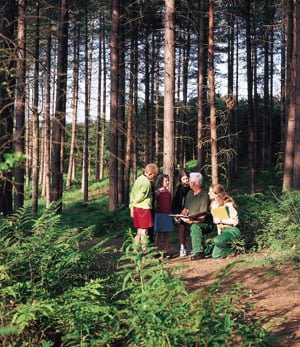
Sherwood Forest is an environmentally sensitive area. When Center Parcs set up there, the company recognised the need to take account of the concerns of any person or group who might be affected by the project. Organisations have a prime responsibility to serve these stakeholders. Primary stakeholders are those with a formal, official or contractual relationship such as shareholders, employees, suppliers and customers. Secondary stakeholders include the local community, consumer organisations as well as the general public.
Impact on the local economy
The Center Parcs project in Sherwood Forest is close to Mansfield and Ollerton. This used to be a coal mining area. The closure of the mines led to severe structural unemployment. The arrival of Center Parcs had several beneficial effects:
- Constructing the project injected income and generated local jobs. The company spent around £22 million – equivalent to more than £35 million in 2001. The local economy benefited by about £12 million from this ‘one off’ expenditure.
- Operating Center Parcs Sherwood Forest generates ongoing jobs and income. Around 1,000 highly varied jobs have been created on site e.g. leisure managers, beauty therapists, chefs. Center Parcs injects over £7 million each year in wages and salaries into the local economy.
- Center Parcs’ policy is to purchase locally wherever possible. This benefits local suppliers such as builders, laundry companies, caterers, florists. Businesses within the local economy of this Center Parcs site generate an additional 140 jobs as a direct result of the presence of the Center Parcs village.
- Many Center Parcs’ visitors either visit local businesses on their way to or from the Center Parcs village, or visit other attractions outside the village. Other tourist activities around the Sherwood Forest site have benefited as a result of Center Parcs being there.
The multiplier effect

The overall impact of an investment into a local economy will be much greater than the size of the initial injection of income. This is because the people who benefit from the initial injection (local workers and local businesses) themselves re-spend much of the income they receive. They also spend much of it locally. This in turn creates further jobs: a multiplier effect is at work. Economists estimate that the existence of Center Parcs has created a further 1,400 jobs over and above the people employed at the centre itself. Because Center Parcs is open all year round, these other jobs are all year round jobs too. The development has avoided the seasonal nature of many jobs associated with tourism and leisure.
Environmental impact
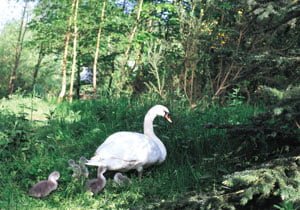
The Netherlands is probably the most environmentally sensitive nation in Europe. Center Parcs developments in Britain reflect this care and concern. They demonstrate that large developments can still be managed in a manner that is sensitive to the environment.
When the Sherwood Forest development was first proposed, an Environmental Impact Assessment (EIA) was carried out in advance of applying for planning consent. If environmental problems had been identified, then the project would not have gone ahead. Careful monitoring of contractors ensured that the environment was protected as construction took place. Once open, the monitoring has continued so as to verify that the environmental requirements can be sustained in the long term and that no creeping long term deterioration is taking place.
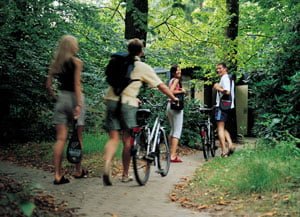
The Sherwood Forest site is set within 400 acres of what had been non-native coniferous plantation woodland. Conifer forests are low in biodiversity. Although it has been difficult to integrate biodiversity into the overall planning, Center Parcs has been determined to do so. Biodiversity is now an integral part of the overall concept. Setting up Sherwood Forest began with thinning the forest. Over 500,000 trees and shrubs were planted, and selected grass and wildflower species were sown. A network of lakes and waterways was created to form a key element of the village. Plants and trees introduced to these areas provided a new habitat that has attracted new life forms. This allows guests to relax amongst a variety of native flora and fauna.
In Sherwood Forest, heathland is naturally re-appearing in some areas. Heathland insects are re-establishing themselves too. More than 113 species of birds have been recorded on the village, including woodcock, tawny owl, green woodpecker and tree pipit. A specialist study of algae in the main lakes and ponds identified seven species of international importance. Not surprisingly, the Sherwood Forest site has won several awards, including the Business and Industry Environment Award.
Conclusion
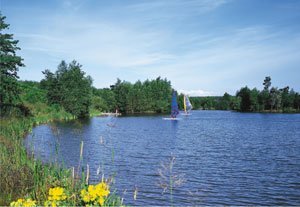
‘To succeed, tourism in the community must be planned and managed to improve the quality of life of the residents and to protect the local, natural and cultural environment’. That is the view of the World Tourism Organisation. Center Parcs, from its first village through to the building of its third village in Longleat Forest, has shown that tourism can be sustainable and that by investing in biodiversity through the process of environmental management, it is possible to integrate a leisure development with a valuable part of our natural heritage.
